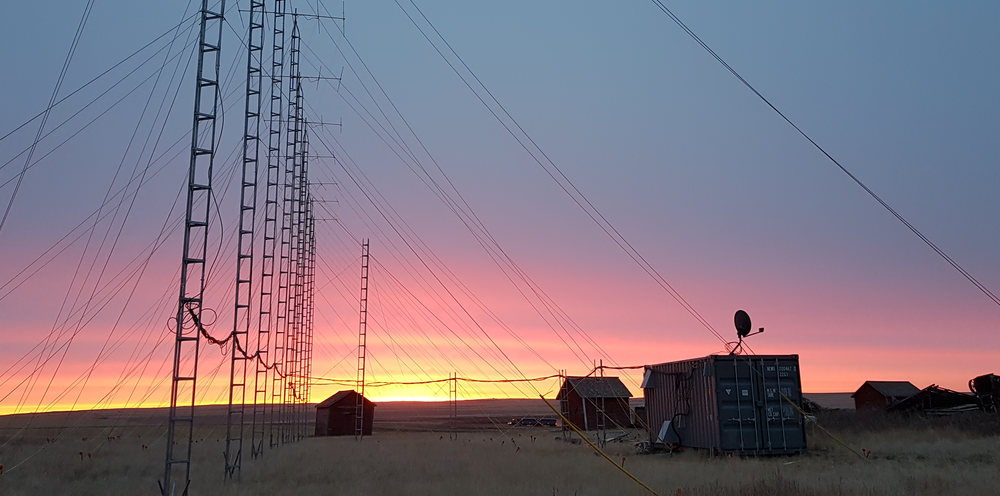Atmospheric Turbulence Triggered by Events 20,000 km Up
Plasma turbulence in Earth’s ionosphere can disrupt radio communications, the GPS system, and even global internet connectivity. Yet it remains difficult to predict, as it depends on complex events linked to the steady stream of solar particles called the solar wind. Now researchers have shown that a period of intense turbulence in one location in the ionosphere had a specific cause in near-simultaneous electric-field oscillations some 20,000 km away [1]. This trigger was located within the plasma associated with Earth’s magnetic field, far above the atmosphere. The finding could help researchers improve techniques for monitoring and predicting space weather.
Electrical storms produce particularly intense plasma turbulence in the ionosphere’s E-region, which lies 90–150 km above Earth’s surface. These storms can be strongly influenced by events in the magnetosphere, a region that extends far above the atmosphere to the areas where Earth’s magnetic field interacts with the solar wind. But many details remain unknown. “We don’t know exactly how this [magnetosphere–ionosphere] connection manifests in the various physical processes that are active around the Earth,” says Magnus Ivarsen of the University of Oslo, Norway. Ivarsen and his colleagues now believe they have found evidence of a link between ionospheric turbulence and a trigger in the magnetosphere.
Ivarsen and colleagues searched for such a connection by exploiting two distinct observational systems that gather data simultaneously on key regions of the ionosphere and the magnetosphere that are known to interact. Between January 2020 and June 2023, Arase, a Japanese inner-magnetosphere spacecraft, collected data on magnetospheric activity above the northern hemisphere. The researchers combined this dataset with other data collected by a Canadian radar installation called ICEBEAR. This ground-based observatory scans the ionosphere with radar, looking for reflections, which indicate plasma turbulence caused by active auroras.
Using these two datasets, the team looked for correlations between events in the ionosphere and the magnetosphere and found one significant event. The radar data showed a short-lived cluster of a few thousand radar echoes detected over a 12-minute interval on May 12, 2021. Ivarsen says the radar echoes appeared between two pulsating auroral patches.
Significantly, data from Arase showed—seconds earlier—a burst of activity in a region of the magnetosphere that was nearby in terms of latitude and longitude. Ivarsen and his colleagues point to this activity as the cause of the ionospheric turbulence. The satellite measured strong electric fields fluctuating at frequencies between 0.1 and 20 kHz, a range corresponding to two types of plasma waves that are generated by wave–particle interactions associated with the solar wind
“It’s surprising that you observe two turbulent signals [that are] separated by 5 times Earth’s radius,” Ivarsen says. And he says that the shape and timing of the signals match to a high degree of precision.
The only viable explanation the team could find for this coincident detection was that wave–particle interactions in the magnetosphere transferred energy to electrons in the observed region. These electrons then produced localized bursts of light akin to the northern lights that in turn caused ionization of air molecules and electric-field enhancements in the E-region of the ionosphere. As a result, it seems that detection of small-scale plasma turbulence in the E-region signals a larger energy input in the magnetosphere, the driving force behind space weather events, Ivarsen says.
“This paper helps to hammer down the connection between currents high in the magnetosphere and plasma turbulence in the lower ionosphere,” says Meers Oppenheim, an expert in space plasma physics at Boston University. “The problem scientists have long had is that strong, filamented electric currents zip around the ionosphere, and it’s very difficult to follow them from the magnetosphere into the ionosphere. This paper finally seems to do that.”
Ivarsen hopes that future observations can gather a more extensive set of data characterizing this kind of production of ionospheric turbulence by magnetospheric processes. “We hope our work can help further understanding of when and where radio communication signals get disrupted by unpredictable space processes and perhaps eventually allow predictions similar to weather forecasting.”
–Mark Buchanan
Mark Buchanan is a freelance science writer who splits his time between Abergavenny, UK, and Notre Dame de Courson, France.
References
- M. F. Ivarsen et al., “Characteristic E-region plasma signature of magnetospheric wave-particle interactions,” Phys. Rev. Lett. 134, 145201 (2025).





